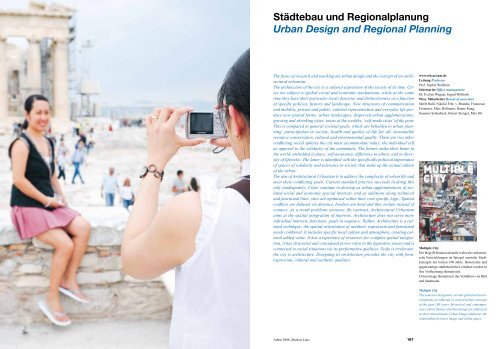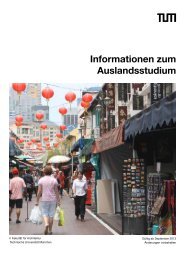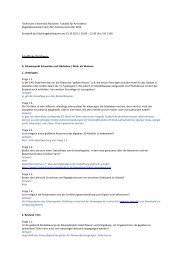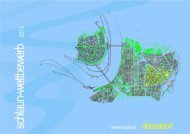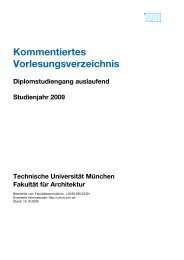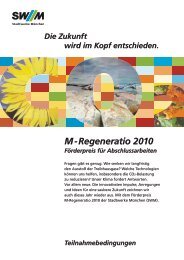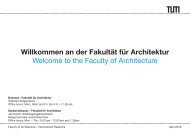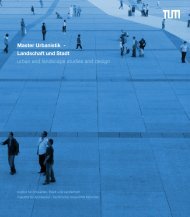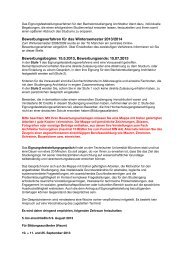Institute Institutes - Fakultät für Architektur - TUM
Institute Institutes - Fakultät für Architektur - TUM
Institute Institutes - Fakultät für Architektur - TUM
Sie wollen auch ein ePaper? Erhöhen Sie die Reichweite Ihrer Titel.
YUMPU macht aus Druck-PDFs automatisch weboptimierte ePaper, die Google liebt.
Städtebau und Regionalplanung<br />
Urban Design and Regional Planning<br />
The focus of research and teaching are urban design and the concept of an architectural<br />
urbanism.<br />
The architecture of the city is a cultural expression of the society of its time. Cities<br />
are subject to global social and economic mechanisms, while at the same<br />
time they have their particular local character and distinctiveness as a function<br />
of specific policies, history and landscape. New structures of communication<br />
and mobility, private and public, cultural representation and everyday life produce<br />
new spatial forms: urban landscapes, dispersed urban agglomerations,<br />
growing and shrinking cities, towns of the wealthy, ‘self-made cities’ of the poor.<br />
This is compared to general societal goals, which are beholden to urban planning:<br />
participation in society, health and quality of life for all, sustainable<br />
resource conservation, cultural and environmental quality. There are two other<br />
conflicting social spheres the city must accommodate today: the individual self<br />
as opposed to the solidarity of the community. The former make their home in<br />
the world, embedded in place, self-assurance, difference to others, and in diversity<br />
of lifestyles. The latter is identified with the specifically political importance<br />
of spaces of solidarity and tolerance in society that make up the actual culture<br />
of the urban.<br />
The aim of Architectural Urbanism is to address the complexity of urban life and<br />
meet these conflicting goals. Current standard practice succeeds in doing this<br />
only inadequately: Cities continue to develop as urban agglomerations of isolated<br />
social and economic special interests, and as additions along technical<br />
and functional lines, sites are optimised within their own specific logic. Spatial<br />
conflicts are defused via distance, borders are hard and they isolate instead of<br />
connect. As a result problems increase. By contrast, Architectural Urbanism<br />
aims at the spatial integration of interests. Architecture does not serve mere<br />
individual interests, functions, goals in sequence. Rather, Architecture is a cultural<br />
technique: the spatial articulation of aesthetic expression and functional<br />
needs combined. It includes specific local culture and atmosphere, creating cultural<br />
added value. It has a repertoire of resources for complex spatial integration,<br />
it has structural and conceptual power (also in the figurative sense) and is<br />
connected to social situations via its performative qualities. Scale is irrelevant;<br />
the city is architecture. Designing its architecture provides the city with form,<br />
expression, cultural and aesthetic qualities.<br />
166 Athen 2008, Markus Lanz<br />
167<br />
www.stb.ar.tum.de<br />
Leitung Professor<br />
Prof. Sophie Wolfrum<br />
Sekretariat Office management<br />
Dr. Evelyn Wegner, Ingrid Wolfrath<br />
Wiss. Mitarbeiter Research associates<br />
Merle Bald, Nikolai Frhr. v. Brandis, Francesca<br />
Fornasier, Marc Hofmann, Hanne Rung,<br />
Susanne Schaubeck, Heiner Stengel, Max Ott<br />
Multiple City<br />
Der Begriff benennt aktuelle weltweite urbanistische<br />
Entwicklungen im Spiegel zentraler Stadtkonzepte<br />
der letzten 100 Jahre. Historische und<br />
gegenwärtige städtebauliche Leitideen werden in<br />
ihre Verflechtung thematisiert.<br />
Urban Image thematisiert das Verhältnis von Bild<br />
und Stadtraum.<br />
Multiple City<br />
The semester designates current global urban development<br />
as reflected in central urban concepts<br />
of the past 100 years. Historical and contemporary<br />
central themes of urban design are addressed<br />
in their interrelation. Urban Image addresses the<br />
relationship between image and urban space.


